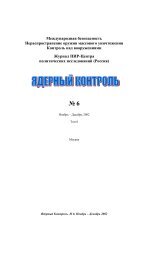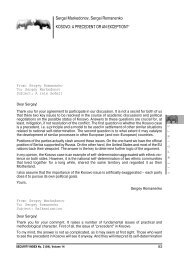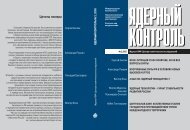Ekaterina Shadrina THE GREAT CASPIAN CAVIAR GAME
Ekaterina Shadrina THE GREAT CASPIAN CAVIAR GAME
Ekaterina Shadrina THE GREAT CASPIAN CAVIAR GAME
Create successful ePaper yourself
Turn your PDF publications into a flip-book with our unique Google optimized e-Paper software.
volume of TPCs for Turkmenistan was not considered due to the absence of a representative<br />
from the country at the session. Significant changes were also seen in export quotas for sturgeon<br />
meat and caviar for 2006. When compared to 2005, the caviar export quota of the<br />
Russian Federation for the following year was reduced from 21 tons to 3.9 tons, for Iran from<br />
60 tons to 51 tons, for Kazakhstan from 15.9 tons to 13.2 tons, and for Azerbaijan from 6.7<br />
tons to 6.5 tons. 63 The parties also coordinated export quotas for sturgeon caviar and other<br />
food products, in compliance with CITES Resolution 12.7, and the export quota for beluga<br />
caviar was reduced by 50 percent, for sevruga caviar by 40 percent, and for osetr caviar by<br />
10 percent.<br />
The Caspian countries are gradually increasing the capacity of hatcheries, which could generate<br />
positive results in the long term (the age at which sturgeon reach maturity and start to produce<br />
caviar is 10-12 years). Over the last 50 years the number of young released from sturgeon<br />
hatcheries of the Caspian countries has increased by dozens of times: from 2.59 million<br />
in 1955 to 79.41 million in 2005. Russia is the country most active in restocking the sturgeon<br />
population, at 56.7 percent. Iran’s contribution runs to 21.6 percent, Azerbaijan–13.1 percent<br />
and Kazakhstan–7.5 percent. Russian sturgeon from the Volga amounts to more than 90 percent<br />
of the number of fish currently in the sea. Russian territorial waters hold the majority (60<br />
percent) of the total stocks of sevruga. 64<br />
Regional cooperation will also develop under the Framework Convention for the Protection of<br />
the Marine Environment of the Caspian, signed by all the Caspian countries in Tehran in 2003.<br />
The goal of the Tehran Convention is the protection of Caspian Sea environment from all<br />
sources of pollution, as well as the protection, preservation, and rational use of the resources<br />
of the Caspian. This document also stipulates independent or joint application of all related<br />
measures to prevent pollution, as well as the protection, preservation, and restoration of the<br />
environment of the Caspian Sea. One of the main principles that will govern the parties in<br />
implementing the provisions of the Convention is the principle that the polluter pays, according<br />
to which the party which inflicts an adverse impact on the sea basin will meet the costs of<br />
measures to prevent, control, and reduce pollution of the offshore environment of the<br />
Caspian.<br />
The Convention was signed by Iran, Russia, Azerbaijan, and Kazakhstan, while Turkmenistan<br />
also acceded to the Convention later. The Tehran Convention is the first document to be signed<br />
by all the Caspian countries, and creates a foundation for the passage of other multilateral<br />
agreements. Among these are an agreement for the preservation of the biological resources of<br />
the Caspian, and an agreement on cooperation in the fields of hydrometeorology and sea pollution<br />
monitoring. The Convention officially came into force on August 12, 2006, following its<br />
ratification by the last of the Caspian countries: Azerbaijan.<br />
In fall 2006, verification measures commenced in three Caspian countries: parallel audits by<br />
the Russian Federation Audit Chamber, the Azerbaijan Audit Chamber, and the Accounting<br />
Committee for Control over the Use of the Budget of the Republic of Kazakhstan. These<br />
audits are assessing the effectiveness of the use of the aquatic bioresources of the Caspian<br />
Sea, as well as the resources allocated for the protection, preservation, restoration, and<br />
rational use of sturgeon. It is possible that the corresponding agencies in Iran will also<br />
become involved in this effort. As yet, it is too early too judge how effective these steps are<br />
likely to be.<br />
A N A L Y S E S<br />
<strong>THE</strong> ACTIONS OF INTERNATIONAL ACTORS<br />
The European Union, as one of the main importers of caviar, is actively taking measures to<br />
combat the penetration of illegal products onto European markets. For example, an EU resolution<br />
(which came into force on July 9, 2006) adopted new labeling rules for member countries,<br />
obliging all parties to use CITES labels. The new rules stipulate that importers indicate the<br />
place and date where a product was caught, to confirm its legal origin. EU Commissioner for<br />
Environment Stavros Dimas expressed the hope that the new rules would facilitate the restora-<br />
SECURITY INDEX No. 1 (81), Volume 13<br />
69








